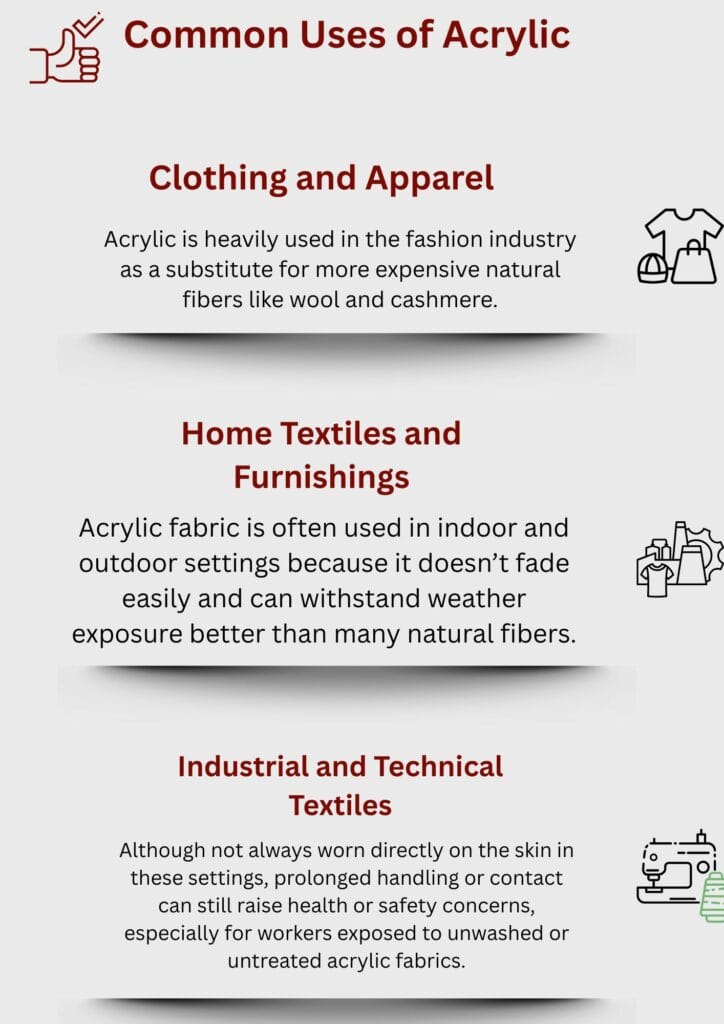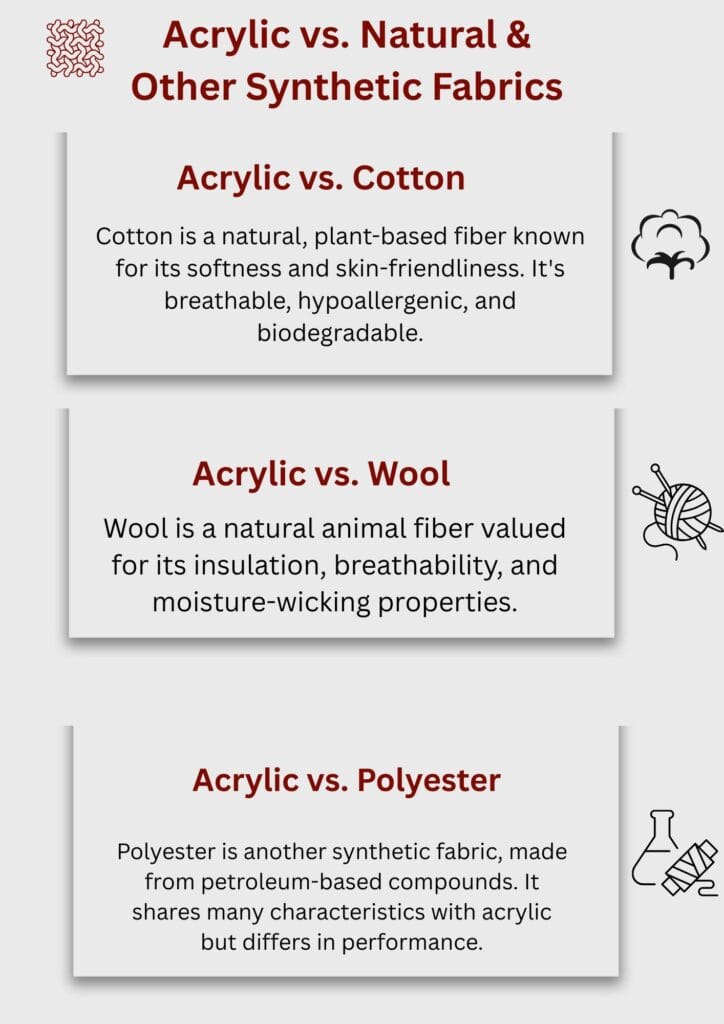Introduction
What Is the Acrylic Fabric?
Acrylic fabric is synthetic and petroleum based, having been manufactured with the use of polyacrylonitrile. Invented in mid-20th century, it was to be a replacement to wool which is soft and warm. Acrylic is greatly applied on a variety of textile materials nowadays.
Acrylic is not of plant or animal origin since it is man made. This renders it non-biodegradable and it is heavily processed by means of its manufacturing. This notwithstanding, acrylic still finds consumption across the globe owing to the versatile nature of this material.
Common Uses of Acrylic
You will get acrylic in winter clothes such as scarves, gloves, sweaters and also in blankets and upholsteries. It is predominantly used in fast fashion and products that are in home goods since it is cheap and mass-production is easy.
Its weightless quality makes it one of the best choices of any lighter outerwear skins, and it gets along with different fibers. Acrylic is also utilized by numerous active wear companies in terms of moisture wicking units as well as thermal abilities.

Why Acrylic Is Popular?
It is preferred as acrylic is lightweisted, warm and colorfast. It takes strong dyes more readily than most natural materials and it is not prone to creasing. More to the point, it is much less expensive than wool or cotton.
Acrylic appears to be a dream to those of us who are conscious about our financial means or want clothes that do not demand too much care. However, it is possible to note that behind these advantages there are more health, safety, and environmental concerns.
How Acrylic Fabric Is Made
Chemical Composition: What Is It Made Of?
This fabric acrylic is mostly composed of polyacrylonitrile that is a polymer obtained through acrylonitrile which is a petroleum-based chemical substance. This makes acrylic strong and elastic, but it also implies that the fabric is not natural and full of chemicals.
This synthetic fiber has approximately 85 percent of acrylonitrile units. Such chemical components are touted as strong yet issue red flags in regard to toxicity and prolonged exposure.
How Acrylic Fabric is made?
It begins by polymerization, that is, the acrylonitrile molecules are connected to form long chains. These chains are later dissolved in a solution and spun into fibers either through wet or dry spinning process.
After forming the fibers, they are washed, stretched out and crimped to soften and become wool like. The fabric then will be available to use after dyeing and finishing. All these take a lot of energy and depend on petrochemicals.
Manufacturing Process of Acrylic Fabric
Acrylic is neither breathable nor environment friendly when compared to natural fibers such as cotton and wool. Both cotton and wool are hypoallergenic and breathable with wool being self insulating.
Acrylic is similar to polyester and nylon though it is softer and wool-like among synthetic fiber. But it is not as resilient as nylon, not as elastic, and more plastic micro fibers are released than with polyester.
Comparing Acrylic with Other Fabrics
Acrylic is not breathable and environmental-friendly as compared to natural fibers such as cotton and wool. Cotton does not cause allergies and they breathe in addition to wool being insulating.
Acrylic as one of the synthetic fibers resembles polyester and nylon but it is more soft wool-like. It is not as durable and elastic like nylon and releases more microplastics compared to polyester, though.
Potential Health and Safety Concerns
Skin Irritation and Allergies
Acrylic fabric safe to wear? One of the most important questions with which one ought to concern himself when dealing with is skin reactions when using acrylic fabric. Acrylic may cause itches or rashes or irritation even to those who have tender skin or eczema.
This is as a result of the reason that the fiber lacks in the art of breathing or even holding heat and moisture. Also, there are remnant chemicals of the manufacturing procedure that may be left in the fabric, resulting in allergic contact dermatitis.
Who Is Most at Risk?
The most vulnerable ones are people with previous skin conditions like eczema or psoriasis.
On their part, inability to deal with long contact with acrylic or use of a base layer underneath may mitigate the symptoms of such individuals.
Chemical Exposure in Acrylic Fabric
In the manufacturing, toxic chemicals are employed such as acrylonitrile and formaldehyde. Both have been observed as possibly cancer-causing when used in excessive quantity or when repeatedly exposed to them.
These chemicals could leave tiny traces even after production that could be a hazard to the user directly on their skin, not pre-washed.
Breathability and Comfort
Acrylic does not provide breathability in the skin. It is likely to retain sweats and body heat, which is uncomfortable during hot weather and when exercising.
Compared to cotton or bamboo fabrics, acrylic is not as natural and can be uncomfortable over repeated wear mostly to those individuals who have sensitive or reactionary skin type.
Environmental & Ethical Concerns
Microplastic Pollution
Whenever acrylic clothes are cleaned, they release micro plastic fibres in the waters. These fibers are so small that they are not filtered and end up in oceans to negatively affect the marine life and get into food chain.
This contributes to the use of acrylic as a great source of microplastic pollution together with polyester and nylon. Its effect on the environment is irreversible.
Non-Biodegradability
Acrylic cloth is not biodegradable and thus it does not decompose easily in landfills. A single piece of acrylic sweater could spend more than 200 years in the process of decomposing, contributing to the ever-aspiring textile waste issue in the world.
This is an eco-unfriendly burden, which takes it out of the running among the sustainable fashion enthusiasts or those attempting to minimize their carbon footprint.
Carbon Footprint Production
Manufacture of acrylic uses a lot of energy and releases toxic gases, which contributes to global warming. It is also dependent on petroleum that is related to oil industry that is environmentally destructive.
Such characteristics as carbon footprint give acrylic great disadvantage in comparison with natural fibers and it is one of the most unfriendly textile materials to nature.
Ethical Manufacturing Problems
Most of the factories producing acrylic are set in low labor standards countries. Employees can become exposed to toxic substances and chemicals without the proper protection or rights setting up ethical issues about its production.
In this regard, a decision in favour of acrylic favours a system that requires unsafe working conditions, which is what a sizeable number of conscientious consumers attempt to shun.
Acrylic vs. Natural & Other Synthetic Fabrics

Pros of Acrylic Fabric
There is a lot to like about acrylic:
- Low cost and cost effective
- Anti-Wrinkle and shrunken resistant
- Fade resistant and dyes well
- Light-weight and warm
All these are the characteristics which make it a reasonable option of winter attire and casual wear.
Cons of Acrylic Fabric
Although it has some advantages, acrylic has serious disadvantages:
- Inefficient breathability and sweating absorption
- Can irritate the skin or can be allergic
- Not environmentally friendly because of microplastic and energy consumption
Such disadvantages tend to surpass the health or environment-friendly consumers.
A comparison with Cotton
Cotton is a natural fibre, which is breathable and free of allergies. Cotton does not keep the heat trapped, like acrylic, nor can it easily cause irritation of the sensitive skin. Nevertheless, cotton wrinkles and shrinks.
A comparison with Wool
The wool is highly insulating and anti-microbial in nature. It is an excellent alternative to acrylic that is completely natural but may be rather pricey and even itchy without treatment in some cases.
Comparison with Polyester
Polyester is like acrylic, with the addition that it is typically tougher and that it draws moisture. Nevertheless, the two add to the plastic pollutant problem. Well, polyester is less irritating than acrylic but cannot be any warmer.
Is Acrylic Fabric Safe for Babies & Children?
Risks of Skin Sensitivity in Infants
The skin of the babies is sensitive and hence they are easy irritants. The use of acrylic clothes may cause rashes, red skin or itching especially when they come into direct contact with the skin.
Precaution should be taken by not allowing needless contact with synthetic fabric by using organic cotton or bamboo fabrics in case of freshly born babies and infants.
Flammability Concerns
Acrylic is flammable and with exposure to heat, it melts. This is particularly harmful to the little kids as molten acrylic may severely burn them. Acrylic sleep clothes or loose lounge clothes should be avoided on children.
Pediatrician Recommendations
A lot of children doctors advise dressing children in natural breathing materials. When using acrylic, it must be limited to small amounts. When it is used, there should be layers beneath it. One should definitely avoid it in case a child has allergies or skin problems.
How to Make Wearing Acrylic Safer
New Acrylic Clothing
New acrylic clothes should always be washed before use. This assists in getting rid of leftover manufacture chemicals. Opt out on charcoal-based detergents and stick to usages of soft non-fragranced detergents that pose fewer chances of skin irritation risk.
Choosing High-Quality Acrylic Blends
Seek clothes that are of acrylic mixes such as acrylic-cotton or acrylic-wool. Such combinations tend to be more breathable, softer, as well as to diminish the chance of irritation.
Alternatives for Sensitive Skin
In case you have a sensitive skin, go with natural fibers such as organic cotton, bamboo or Tencel. They are naturally hypoallergenic, breathable and bio-compatible, thus safer and comfortable to wear as well.
Proper Care to Reduce Microplastic Shedding
Wash in cold water and use laundry bags with microfiber catching properties that prevent microfiber shedding. Do not wash too often and line-dry when possible, to make the fabric last long and limit negative influences on the environment.
Expert Opinions & Studies
Dermatologists’ Views on Synthetic Fabrics
Majority of dermatologists confirm that synthetic fabrics can have the capacity to cause conditions of the skin particularly in sensitive individuals. They recommend that you avoid contact with acrylic when you have allergies, eczema or chronic skin problems.
Research on Acrylonitrile Exposure Risks
Research has demonstrated how acrylic which has acrylonitrile as chemical can be detrimental to the health on long-term basis by chronic exposure. Clothing levels are not very high but repeated contact can be dangerous to some people.
Environmental Studies on Microplastics
Scientific studies have proved that acrylic is a major source of pollution to microplastic. A study discovered that more than 35 per cent of microplastics in the ocean are made up of synthetic fibres, most of which is the result of laundry waste.
Conclusion
Whether acrylic fabric is safe to wear or not does not give a one-answer-fits-all scenario. Acrylic cloth has advantages such as economics, warmth and color fastness, the reason why it is widely used in fashion and furnishing accessories. Yet its synthetic propensity, its tendency to cause skin irritation and its effect on the environment cannot be overlooked.
In the vast majority of cases, acrylic can be worn on rare occasions without much danger to it. However, to some people: individuals with sensitive skin, allergies, with young children, etc., the chemical hazards might just be greater than the rewards. Acrylic may hold heat, produce irritation and release microplastic into the environment each time it is washed. According to its non-biodegradable structure and heavy use of chemicals in the production process, too, it sets forth ethical and ecological red flags.


